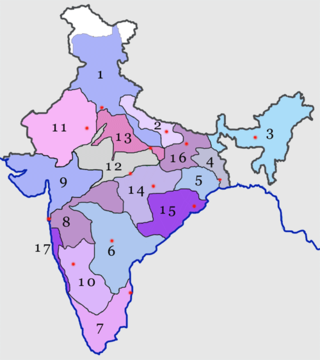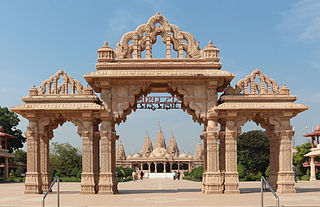
India is a federal union comprising 28 states and 8 union territories, with a total of 36 entities. The states and union territories are further subdivided into districts and smaller administrative divisions.

Bombay State was a large Indian state created at the time of India's Independence, with other regions being added to it in the succeeding years. Bombay Presidency was merged with the princely states of Baroda, Western India and Gujarat and the Deccan States.

Kathiawar is a peninsula, near the far north of India's west coast, of about 61,000 km2 (23,500 sq mi) bordering the Arabian Sea. It is bounded by the Gulf of Kutch in the northwest and by the Gulf of Khambhat in the east. In the northeast, it is connected to the rest of Gujarat and borders on the low, fertile hinterland of Ahmedabad. It is crossed by two belts of hill country and is drained radially by nine rivers which have little natural flow aside from in monsoon months, thus dams have been built on some of these. Kathiawar ports have been flourishing centres of trade and commerce since at least the 16th century.

Saurashtra, also known as Sorath or Kathiawar, is a peninsular region of Gujarat, India, located on the Arabian Sea coast. It covers about a third of Gujarat state, notably 11 districts of Gujarat, including Rajkot District. It was formerly a state of India before it merged with Bombay state. In 1961 it separated from Bombay and joined Gujarat.

The Western Railway is one of the 19 zones of Indian Railways and is among the busiest railway networks in India, headquartered at Mumbai, Maharashtra. The major railway routes of Indian Railways which come under Western Railways are: Mumbai Central–Ratlam, Mumbai Central–Ahmedabad and Palanpur–Ahmedabad. The railway system is divided into six operating divisions: Ahmedabad, Vadodara, Rajkot, Bhavnagar, Ratlam, and Mumbai WR. Vadodara railway station, being the junction point for the Ahmedabad–Mumbai route and the Mumbai–Ratlam route towards New Delhi, is the busiest junction station in Western Railways and one of the busiest junctions of Indian Railways too, while Ahmedabad Division earns highest revenue followed by Mumbai Division and Vadodara Division. Surat railway station is one of the busiest railway station in Western Railway in non-junction category where more than 180 trains pass per day.

Rajpramukh was an administrative title in India which existed from India's independence in 1947 until 1956. Rajpramukhs were the appointed governors of certain Indian provinces and states.

Bhavnagar is a city in the Bhavnagar district of the Saurashtra region of Gujarat, a state of India. It was founded in 1724 by Bhavsinhji Takhtasinhji Gohil (1703–1764). It was the capital of Bhavnagar State, which was a princely state before it was merged into the Indian Union in 1948. It is now the administrative headquarters of the Bhavnagar district.
The State Bank of Saurashtra was a government-owned bank in India, with its headquarters at Bhavnagar. It was one of the seven Associate Banks of the State Bank of India, with which it merged on 13 August 2008. At the time of the merger, the bank had a network of 423 branches spread over 15 states and the Union Territory of Daman and Diu.

Uchharangrai Navalshankar Dhebar was an Indian Independence activist who served as the Chief Minister of Saurashtra State from 1948 to 1954 and the President of the Indian National Congress from 1955 to 1959.

Samaldas Gandhi (1897-1953) was a journalist and Indian independence activist who headed the Aarzi Hakumat or Provisional Government of the erstwhile princely state of Junagadh. He was a nephew of Mahatma Gandhi.

Bhavnagar State was a princely state with 13 Gun Salutes during the British Raj. It was part of Kathiawar Agency in Saurashtra.
Jesar is a small town and Taluka of Bhavnagar district of Gujarat.

Junagarh or Junagadh was a princely state in Gujarat ruled by the Muslim Babi dynasty in British India, until its integration into the Union of India in 1948.

Saurashtra, also known as United State of Kathiawar, was a State of India that existed between 1948 and 1956, on Saurashtra alias Kathiawar peninsula, with Rajkot as its capital,

Porbandar State was a princely state during the British Raj ruled by Jethwa dynasty. It was one of the few princely states with a coastline.

The States Reorganisation act, 1956 was a major reform of the boundaries of India's states and territories, organising them along linguistic lines.

The Viramgam–Okha line is a railway passing through Gujarat State, in western India.

Jamnagar railway station is the main railway station in the city of Jamnagar in Gujarat, India. It is located in the Western Railways zone of Rajkot Division. Jamnagar railway station is connected to various parts of India by long-distance trains. Hapa is another railway station located on the eastern outskirts of Jamnagar. It was the fourth cleanest railway station of India according to the latest "Swachh Rail, Swachh Bharat" survey in 2016.

The Kingdom of Rajpipla or Rajpipla State was a princely state, with full internal jurisdiction, in India ruled by the Gohil Rajput dynasty for over 600 years from around 1340 till 1948. It was the largest State, and the only first-class State, of the Rewa Kantha Agency.. Among Gujarat States, Rajpipla State was the second-largest after Baroda (Vadodara) in terms of size and importance. The Gohil Rajput dynasty of Rajpipla survived the onslaught of the Sultans of Ahmedabad and the Mughals during the mediaeval period, and the Gaekwars of Baroda and the British in the modern period, to emerge as a well-administered State with contemporary infrastructure, policies and practices by the time it was merged with the Union of India on 10 June 1948.

Morvi State, also spelled as Morvee State or Morbi State, was a princely salute state in the historical Halar prant (district) of Kathiawar during the British Raj.

















